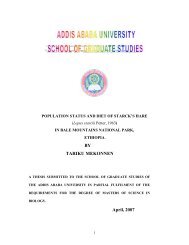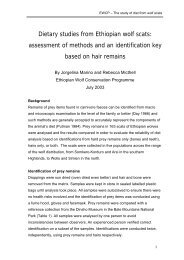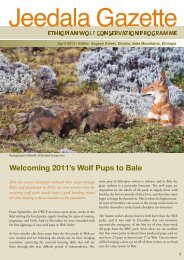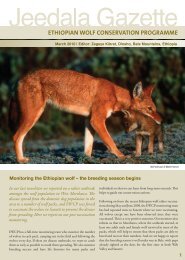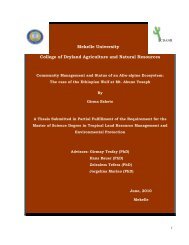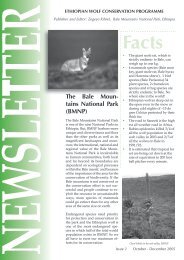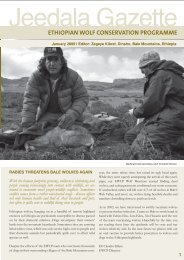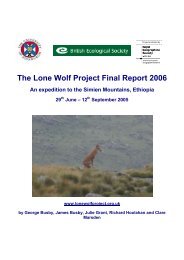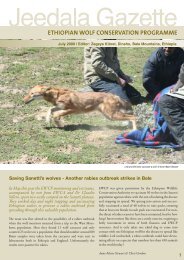pdf -600 KB - Ethiopian Wolf Conservation Programme
pdf -600 KB - Ethiopian Wolf Conservation Programme
pdf -600 KB - Ethiopian Wolf Conservation Programme
Create successful ePaper yourself
Turn your PDF publications into a flip-book with our unique Google optimized e-Paper software.
EWCP Monitoring TeamObjective: Monitor and assess wolfdemographic trends with a focus on Baleand other selected critical populations,measuring levels of livestock (dogs andgrazing stock), habitat loss and persecutionaffecting wolf status.This report gives an overview of the knowndemographic status of the seven <strong>Ethiopian</strong> wolfpopulations at the end of the monitoring year(April 2010 – March 2011). Table 1 provides asummary of the known status of all <strong>Ethiopian</strong>wolf populations, stressing the need for increasedknowledge in several areas. A more detaileddemographic report is also available.An Outbreak of CanineDistemperThe <strong>Ethiopian</strong> wolf population of the BaleMountains was affected by rabies outbreaksin 1991, 2003 and again in 2008/09, withconfirmation that the virus was transmitted tothe wolves from domestic dogs within wolfrange. Although canine distemper virus (CDV)has been suspected in the landscape the onlypreviously known CDV outbreak was recordedon the Sanetti Plateau in 2006. Approximately65% of known wolves in the affected area died ordisappeared as the disease spread from WorgonaValley (Central Peaks) in August 2005 to CentralSanetti in January 2006.Another CDV outbreak was recorded in 2010.A total of 24 wolf carcasses were recoveredfrom all major sub-populations in Bale betweenthe 14th May 2010 and the 17th November2010. Samples were collected from seven wolfcarcasses and sent for testing at the AnimalHealth Veterinary Laboratories Agency (AHVLA)in the UK. Five out of the seven individualsreturned positive results for CDV, while all sevenreturned negative results for rabies. Seven out ofthe 24 dead wolves had been vaccinated againstrabies during the outbreak of 2008/09.Reinforcing pack bonds (photo © M. Harvey)In addition to the carcasses discovered, manymore wolves went missing, especially in the WebValley. While these missing wolves cannot bedirectly linked to the disease outbreak, and it isquite probable that many of last year’s juvenilesdied due to natural mortality, it is likely thatthe CDV epizootic accounted for many morewolves than just the 24 carcasses found. Duringthe rabies outbreaks of 2003 and 2008/09, andthe CDV outbreak of 2005/06, carcasses werediscovered for only 48% of missing wolves.However, the carcass to missing wolves ratiocould be as low as 1 to 5 (21%) in the 2010 CDVepidemic, due to the fact that the team weremonitoring in other locations during what mighthave been the height of the epidemic in the WebValley and East Morebawa.Earlier mathematic modelling exercises carriedout by EWCP and collaborators suggested that<strong>Ethiopian</strong> wolves could cope with outbreaksof rabies or canine distemper, but that themajor worry would be if the disease outbreaksoccurred simultaneously or concurrently. Therabies outbreak of 2008/09, followed by thecanine distemper outbreak of 2010, has seenthis scenario realised. The Web Valley was thepopulation most seriously affected by rabiesin 2008, and it is unsurprising to see how fewadults remain from these six focal packs now,while also recognising that five entire packs havedisappeared from focal areas.EWCP an n u a l re p o r t | 3
Figure 1Overview of the Bale MountainsNational Park showing all <strong>Ethiopian</strong>wolf carcasses found throughoutthe monitoring year 2010-11.Carcasses that were tested forCDV have different symbols.Monitoring of Focal PacksMost focal packs in the Bale Mountains wereseverely affected by disease in the past two years.Five out of 18 focal packs were lost during thisperiod. Tarura, previously a non-focal pack, hasnow been added to the focal packs monitoredin the Web Valley to compensate for these losses.On average, the monitoring team completed 14.6visits to each of three focal areas, spending 26.4days (147 hours) within each focal pack. Theintensity of this monitoring effort, consisting ofrepeated visits throughout the breeding season,allows EWCP to give total figures with highaccuracy for the current 15 focal packs. Twentycarcasses were recovered throughout the yearfrom focal pack territories. The disease outbreakresulted in only three of last year’s 25 pupssurviving to the sub-adult stage (12% survivalrate). Worryingly, the focal packs of the BaleMountains lost 55% of adults and sub-adults overthe course of the year.Overall, 43% of 15 focal packs raised pups toemergence from the den (3 weeks of age). The totalnumber of pups recorded this year (21) was low, evenbefore the difficult 6-month to 1-year independenceperiod, an age group with typically high mortality.Additionally, 21% of packs had pups but lost thembefore emergence. There was no breeding this year inthe remaining 36% of focal packs.Central SanettiFocal packs in Central Sanetti were affectedby the CDV epizootic, with seven carcassesrecovered but many more animals missing fromlast year. The total number of adults and subadultsdecreased by 41% over the last year. TheSanetti packs have struggled during the pasttwo breeding seasons, with only two successfullitters this season. Only five juveniles reachedindependence. A further two litters were bornthis season but were lost before emergence.Only two of last year’s six pups surviving atindependence became sub-adults this year(33% survival rate). The monitoring team havebenefitted greatly from having so many taggedanimals when it comes to getting more reliablepack compositions. The team also spent muchtime monitoring Dumal pack, continuing thework of Freya van Kesteren’s research of theprevious year, thus effectively there were sevenfocal packs in Central Sanetti.EWCP an n u a l re p o r t | 4
Web ValleyThe Web Valley focal packs were seriouslyaffected by disease outbreaks: rabies in October2008 followed by CDV during 2010. Four of thefocal packs present prior to 2008 no longer exist.Eight carcasses were discovered this year, andthere were many more animals missing, whencompared with last year’s figures. Overall, 67.7%of adults and sub-adults have disappeared overthe past year. Tarura has now become a focalpack for monitoring purposes to compensatefor these losses. There are only three focal packsin the Web Valley at present. All were relativelysuccessful during the breeding season. All packsbred, and two of those had successful litters, withall nine juveniles reaching independence. Onelitter that was born this season was lost beforeemergence. Only one of last year’s 13 pups thatwere still alive at independence has becomea sub-adult this year (7.7% survival rate). Themonitoring team have benefitted from having sixremaining ear-tagged animals, enabling accuratereporting of pack compositions.East MorebawaThe East Morebawa focal packs were hit hard bythe CDV epidemic in 2010. Focal pack Weshamano longer exists. Five carcasses were discoveredduring this past year, and many more animalswere missing when compared with the figuresfrom last year. East Morebawa lost 68% of itsadult and sub-adult populations in the past12 months. Two packs had successful littersthis season, with all seven juveniles reachingindependence. None of last year’s six pups whoreached independence became sub-adults thisyear (0% survival rate). The monitoring team havebenefitted from having six remaining ear-taggedanimals, enabling accurate reporting of packcompositions.Bale MountainsNon-Focal PacksThe non-focal packs of the Bale Mountainsreceive little attention during the breeding<strong>Ethiopian</strong> wolf carcass, found in the Web Valley duringthe recent CDV outbreak. (photo © C. Libert)season, where monitoring effort focuses on focalpacks, therefore few data on pup survival of nonfocalpacks currently exists. While monitoringfigures for these packs are less accurate, theyhave an important role as an indicator of thesize and structure of the entire Bale population.Figures of remaining sub-adults from theprevious year provide an indicator of the successof the breeding season. As non-focal packs andareas are visited on a handful of occasionsyearly due to limited time and resources, thefigures gathered by EWCP in these areas areconservative estimates designed to provide dataon the minimum number of wolves seen in agiven pack’s known territory.During the 2010-2011 monitoring year 38 of theknown 44 non-focal packs were located. Eachnon-focal area was visited 2.7 times on averagethroughout the year, and the team spent 4.6 days(26.5 hours) working in each pack territory.Eleven carcasses were recovered throughoutthe year from non-focal pack territories, most ofthese in East Sanetti, and two tested positive forCDV. Compared to the major losses seen in thefocal areas, the non-focal area (East Sanetti) thatwas most affected lost 21% of adults and subadultsover the past year. The monitoring effortin the non-focal areas was more comprehensivein 2010-2011 than in 2009-2010, when moreEWCP an n u a l re p o r t | 5
human resources were deployed to deal withthe rabies outbreak during May-June 2009. Thebeginning of the 2011-2012 monitoring year willsee the monitoring team visit several areas of theBale Mountains that were last observed beforethe CDV outbreak, and hopefully these trips donot bring more bad news of further losses fromcanine distemper. At least 21 of the 38 (55%)non-focal packs that were found during the 2010-2011 monitoring year had pups in the 2009-2010breeding season. Of these, there are 27 sub-adultsremaining, and there were at least 12 juvenilesthat did not make it to sub-adult status.Bale Mountains OverviewThe <strong>Ethiopian</strong> wolf population of the BaleMountains receives the most monitoringattention throughout the year owing to therelatively large size of this population, as wellas the disease threats faced in this area. Duringthe course of the year, EWCP conducted 59monitoring trips within the Bale Mountains,totalling 675 days (3,737 hours) spent in thefield actively searching or watching wolves.The Bale mountains wolf population has had aluckless year, with major losses due to the caninedistemper outbreak. Overall, 26% of adults andsub-adults have disappeared during the past 12months, including the loss of six entire packswithin optimal wolf habitat. Additionally, therewere low recruitment levels from juveniles tosub-adults this year, compared to the previousHigh Mountains of Ethiopiathree years, with only 12% of last year’s pups infocal packs becoming sub-adults.Despite the loss of wolves, the Bale Mountainsretain at least 46 individuals that were eartaggedduring the previous rabies vaccinationinterventions of 2003, 2008 and 2009. Theseeasily recognisable individuals significantlyimprove the accuracy of pack compositionreports, particularly in the focal packs. Thesilver lining is that at least 49 of the 57 (86%)remaining packs have a breeding pair ofadults. Should the Bale Mountains have a fewconsecutive disease-free years, these numberswill surely recover to historical levels.Arsi MountainsEWCP continues with annual intensive surveys ofthe Arsi Mountains. While it would be desirableto increase the EWCP presence in the ArsiMountains, this is not possible for the programmedue to financial limitations. The monitoring teamspent 17 days (128.5 hours) of observation effortin Arsi in July 2010, during which the weatheroffered almost constant rain and fog, makingaccurate monitoring very difficult. Monitoringfigures are not 100% accurate and act as anindicator of the size and structure of the ArsiMountains’ <strong>Ethiopian</strong> wolf population. As thesepacks were only visited once during the rainyseason, these figures are conservative estimates,designed to provide data on the minimumnumber of wolves seen in a given pack’s knownterritory. Wolves were seen in seven of ten packsmonitored in Arsi.North EthiopiaSince October 2010, EWCP has employed onefull-time wolf monitor in the North of Ethiopia,through EWCP’s partnership with the FZS there.This monitor spends the majority of his timein the Simien Mountains National Park, withsupplementary monitoring trips to the otherfour <strong>Ethiopian</strong> wolf populations throughout theyear. The monitoring effort for this work will beconcentrated in the Simien Mountains duringthe breeding season, with intensive monitoringsurveys occurring in the other four populationsthroughout the rest of the year.EWCP an n u a l re p o r t | 6
AfroalpinerangeSimien MountainsMt GunaMt ChokeNorth WolloSouth WolloGuassa-MenzGosh MedaArsi MountainsBale MountainsOverallSuitable habitat(km 2 )Population estimate(wolves >1 year old)Populationstatus273 km 2~20 km 2134 km 2140 km 2243 km 2112 km 220 km 2870 km 21,141 km 22,984 km 2 52-75 (2006)(pack observations)4 (2004); 0 (2011)pack observations)-19-23 (2000)(habitat based estimate)16-19 (2000)(habitat based estimate)25 (2004)(pack observations)-54 (2009)(pack observations)~200 (2010)(pack observations)~ 400stable?extinct ~5 years agoextinct ~100 years agostable?stable?declined recently dueto diseases (~40%)extinct ~15 years agostable?declining due to diseasesDeclining(plausible range 360-420)Table 1. Summary of the status of seven <strong>Ethiopian</strong> wolf populations found throughout Ethiopia.Suitable habitat withinprotected areas200 km 2Simien Mountains NP---~20 km 2 Borena SaiyntRegional Park82 km 2 Guassa Community<strong>Conservation</strong> Area-870 km 2 Arsi MountainsRegional Park 1,100 km 2Bale Mountains NP2,270 km 2The benefits of these increased monitoringefforts in North Ethiopia will not becomeapparent until next year’s monitoring reports,when a better monitoring outcome will resultfrom the increased data and presence that EWCPwill have in all North Ethiopia populations. Thisincreased monitoring effort fits in well with theaction plan that is currently being developed asa result of the Strategic Planning for <strong>Ethiopian</strong><strong>Wolf</strong> <strong>Conservation</strong> workshop that took place inLalibela in February 2011.Disease controland preventionObjectives: a multi-pronged approach to reducethe threat that diseases pose to the survival ofthe <strong>Ethiopian</strong> wolf, with the following objectives:i) assess the prevalence and threat of canidpathogens to wolves, ii) gather information onhealth status, diseases and causes of mortality;iii) investigate a vaccination scheme toprotect <strong>Ethiopian</strong> wolves; iv) prevent diseasetransmission from domestic dogsThe EWCP vaccination team vaccinates domesticdogs in and around the Bale Mountains NationalPark against rabies with the objective to decreasethe threat of rabies to <strong>Ethiopian</strong> wolves, as thisdeadly disease is easily spread from the reservoirof domestic dogs to the wolves. Day to day, theteam visits as many villages as possible, educatingvillagers and encouraging them to have theirdomestic dogs vaccinated against rabies. A recentstudy (Abera Yilma, Mekelle University) showedthat vaccinated kebeles (villages) had far fewercases of rabies in people, dogs and livestock thanunvaccinated kebeles.The EWCP vaccination team started their effortsthis year in Adaba Woreda, an important area fordogs moving into the Park and into wolf territory.Eight different kebeles were visited, includingDuro, Bucha and Wesha Lencha, and over 800dogs were vaccinated against rabies.During June, the Simien Mountains NationalPark requested that the EWCP vet team visitthe area to vaccinate dogs in certain kebelesagainst rabies. Two members of the EWCP vetEWCP an n u a l re p o r t | 7
team, accompanied by the EWCP communityoutreach officer travelled to North Gondar andvaccinated close to 180 dogs, with the supportand cooperation of the local woredas and thecommunities. The team then visited Guassa,North Shoa, as there had been a report of dogsand wolves dying in the area. They vaccinated310 dogs there.In Bale, the team was very busy during the rainyseason and visited over 20 different kebelesin the Web Valley and Morebawa, includingSodota, Tarbo, Genale, Chalalaka, Horgoba andGurati. They were accompanied by the EWCPCommunity Liaison Officer for much of the time,who assisted them by talking to the communitiesabout the importance of vaccinations. Despitethe heavy rain and difficult conditions, the teamvaccinated over 620 domestic dogs duringthis time. However, over 100 dogs in thesevillages remain unvaccinated and it is up to thecommunity members to support the team whenthey arrive by catching their dogs for vaccinations,and making sure that all the dogs they own arevaccinated. It only takes one unvaccinated dog tostart a rabies outbreak in a village.From October, the team concentrated theirefforts in the Goba Woreda, working in Rira, FasilSura, Fasil Angesu, Lash Kona and East and CentralSanetti, and vaccinating nearly 440 dogs. Thisis apparently a difficult area to work in as thepeople are often not in their villages, the villagesare very scattered, and the dogs are difficult tocatch. In response to a rabies scare, the teamworked in Zallo Ababa in the Dinsho Woreda inFebruary, and vaccinated 110 dogs.In January EWCP learnt that the veterinaryinstitute in Debre Zeit was no longer importingrabies vaccines, which proved problematic to thedog vaccination campaign since the vaccine wasno longer available, resulting in the interruptionof the campaign once EWCP ran out of vaccine.Fortunately, through a generous donation ofvaccines from Intervet/Schering Plough AnimalHealth in April, EWCP will be able to continuewith our dog vaccination campaign.This year the vet team vaccinated a total of 2,465domestic dogs, a very strong effort consideringEWCP is working with only one vaccinationteam, and that there were no vaccines availablefrom January. However, according to the teamleader, Muktar Abute, 531 dogs still remainunvaccinated in the kebeles that they visited, dueto the difficulty in catching these dogs and thelack of cooperation from certain villagers. As aresult the EWCP team therefore vaccinated 82%of dogs they encountered.Education andCommunity outreachObjective: The EWCP education campaign seeksto involve local communities in the protectionof Afroalpine natural resources; continue withthe development of a conservation educationand extension campaign at school andcommunity levels in Bale and other criticalwolf areas.EWCP has a full-time Education Officer basedin Bale, one in Arsi and a third covering thefive northern populations. The EducationOfficers work with local communities andparticularly with the local schools surroundingthe wolf populations. The school educationcampaign focuses on environmental awareness,appreciation of natural resources, the importanceof conserving the <strong>Ethiopian</strong> wolf, diseaseawareness, and the establishment of nature clubs.Bale education programmeThe Bale Education Officer, Zegeye Kibret,regularly visits 11 schools within the Bale area,and this year reached over 2000 students andteachers with his environmental educationprogramme. Schools visited include the DinshoPrimary and Secondary Schools, Soba School,Zallo Ababa Primary School, Abakara, Hersho,Karari, Gofingira, Sanetti Primary and JuniorSchool and Gaysay Primary School. Numerousnational and international schools anduniversities, such as the ICS School, SandfordSchool, Madawalabu University and AwassaUniversity also visited the Park during the year,and were given presentations and led on naturewalks by Zegeye. All school and university groupswere given copies of the EWCP newsletter, theJeedala Gazette.EWCP an n u a l re p o r t | 8
Students and lecturers from Dila University,Wondo Genet University and TVT Batu (over220 in total) visited the National Park and wereshown around and given conservation awarenesstalks by Zegeye, concentrating on the ecology ofthe <strong>Ethiopian</strong> wolf and the threats faced by thisendangered species in the Bale area.Zegeye has helped with the formation of the new‘Experience Your Country Club’, in the DinshoHigh School. The club members often visit thePark, going on walks and picking up litter. EWCPalso encourages the efforts of the newly formedBale Beauty Band, a drama group that stages playsand writes songs about the Afroalpine ecosystemand the <strong>Ethiopian</strong> wolf.Zegeye also continued with his conservationawareness training of the tourism guides fromthe Nyala Guides Association. Eight guidesare taking part in this training initiative,which teaches them more about their naturalenvironment, ecosystem processes andunderstanding the needs of tourists.At the end of September, World Rabies Day wascelebrated in Dinsho. The EWCP EducationOfficer, Field Director and Technical Coordinator,and the teachers and pupils from Dinsho PrimarySchool staged a march along Dinsho main roadprotesting about rabies and asking people tohave their dogs vaccinated in order to protectEthiopia’s unique wildlife. The celebrationscoincided with Market Day in Dinsho, whichallowed the school children to hand out rabiespamphlets to farmers coming into town.Back at the school, the pupils staged variousperformances highlighting the dangers of rabiesto people and wildlife, and the importance ofdog vaccinations.In March 2011, the 13th successful <strong>Wolf</strong> Daywas celebrated in Bale, with the usual variety ofsporting events and competitions. The recentlyformed Bale Beauty Band performed a numberof songs they had written about the highlandsand the wolves, and kept the crowds entertainedwith plays and poems. The Dinsho Woredareceived an award in recognition of their supportfor EWCP, particularly the dog vaccinationprogramme, while the Bale Beauty Nature Clubwas also acknowledged for its contribution toconservation and environmental education.Children in Dinsho raising awareness aboutthe dangers of rabies during World Rabies Daycelebrations (photo © EWCP)Members of the vaccination team, and educationand outreach team enjoying the sunshine in theWeb Valley (photo © EWCP)CommunityOutreach in BaleIn 2009, EWCP appointed a new Bale CommunityLiaison Officer, Mustafa Dule, whose primaryobjective is to visit local communities withinand surrounding the National Park to educatethem about natural resource protection and theconservation of the wolves. Mustafa also assessesthe understanding of the communities onconservation issues relating to the National Parkand how this affects them, while simultaneouslyidentifying the needs of the communities andhow these needs complement or conflict withconservation efforts. This allows EWCP as well asits partner organisations to better address threatsto the Afroalpine.Mustafa has also been preceding the vet team tovillages where they vaccinate dogs, to talk to thecommunities about the threat of rabies and theimportance of dog vaccinations, which allowsthe vet teams to operate more effectively. Mustafais in regular contact with the Dinsho woredaand is responsible for keeping them informed ofEWCP an n u a l re p o r t | 9
EWCP activities while ensuring their continuedsupport for EWCP projects.Over the past year, the EWCP field teams(monitors and vet team) have been collectingopportunistic information on new settlementsand crops they encounter in Bale MountainsNational Park. This information has been passedon to the Park management and EWCA.The November 2010 edition of the Jeedalagazette was printed and distributed this past year,while the May 2011 edition is currently beingcompiled.Arsi <strong>Programme</strong>The EWCP Education Officer in Arsi, DejeneDeme, continues to work with the nature clubshe has founded in the local schools. Dejeneworks in eight secondary schools, regularlyinvolving over 800 teachers and pupils inenvironmental activities and natural resourceconservation. This includes taking the pupilson field trips to the mountains to expose themto the wolves and their habitat. Dejene worksto introduce the concept of sustainable naturalresource use into the schools, using them as aspringboard to making the wider communityaware of these initiatives.Arsi <strong>Wolf</strong> day was held in December 2010, atthe Shirka Secondary School in Shirka Woreda.The celebrations are held in a different Woredaevery year to allow a different school to hostthe day. The day was very successful, with theShirka School demonstrating a commendablecommitment to conservation of the <strong>Ethiopian</strong>wolf and its habitat. Cultural displays, artcompetitions, sporting events and environmentalquizzes all formed part of the celebrations, whichinvolved eight different schools and attractedhundreds of spectators. The wolf day celebrationscoincided with the unveiling of the new naturearea that Shirka Secondary School has set asideadjoining the school grounds.Our Arsi Community Liaison Officer, AsheberAnbessa, works in the various kebelessurrounding wolf populations in the Kaka andChilalo-Galama ranges. Villages that he visitsinclude Hella Sero, Hella Waji, Sole Negelle,Waji Konne, Lemmu and Tijo, speaking toadministrators, elders, women and farmers in eachvillage about Afroalpine and wolf conservation.Their attitude to the wolves is generally positiveand they seem receptive to the idea of wolfconservation, especially in Shirka woreda. Asheberalso works alongside the Oromia Forest andWildlife Enterprise (OFWE), helping them withcommunity meetings and discussions, and hasbeen instrumental in assisting with the boundarydemarcation of the recently established ArsiMountains Regional Park.Unfortunately, however, we have reports of largescalehuman disturbance in the Arsi mountainrange in general, including new settlements andcrops, and the burning of indigenous vegetation(especially Erica) for charcoal. In addition, twofarmers admitted killing two wolves last year.North Ethiopia <strong>Programme</strong>EWCP works alongside the Frankfurt ZoologicalSociety (FZS) in North Ethiopia to educatelocal communities about the wolves and theimportance of Afroalpine conservation. EWCPemploys an Education Officer in the North, andcollaborates with FZS on the production ofeducation material and with community trainingprogrammes.Unveiling the sign for the new nature area in ShirkaSecondary School, dedicated to EWCP (photo © EWCP)2010 has seen renewed efforts in North Ethiopia,with more of EWCP’s resources directed to thisarea. The education programme covers the areasEWCP an n u a l re p o r t | 10
Members of theNature Club at a schoolnear Chennek, SimienMountains National Park(photo © EWCP)hosting the five northern wolf populations,working with established nature clubs in schools,training and supporting teachers and evaluatingclub outputs. The emphasis of the programmeis on coexistence with wolves and sustainableresource use in the Afroalpine highlands.Research andCapacity BuildingObjective: EWCP relies on strong science toinform and develop conservation actionstowards the completion of its main objective:to assess, address and counteract threats tothe survival of <strong>Ethiopian</strong> wolves and theirAfroalpine ecosystem. EWCP is committed tobuilding capacity in Ethiopia in the ecologyand biodiversity conservation field, bothwithin our organisation and the <strong>Ethiopian</strong>conservation community in general.Summary ofResearch ProjectsCommunity management and the status ofthe Afroalpine ecosystem: The case of the<strong>Ethiopian</strong> wolf in Abuna Yosef.EWCP sponsored and co-supervised GirmaEshete, from Mekele University, through hisMSc degree in 2009/2010. Girma successfullycompleted his dissertation on the use of naturalresources by villagers in the Abuna Yosephmountain range, North Ethiopia, and communityperceptions of <strong>Ethiopian</strong> wolves and Afroalpineconservation.In Abuna Yoseph, Girma conducted extensiveinterviews in a random sample of householdsfrom within four kebeles to determine thedependence of families upon Afroalpineresources, and how this translates into attitudesand perceptions towards natural resourceconservation, including <strong>Ethiopian</strong> wolves.He found that households with access toagricultural land supported protection ofnatural resources more than landless ones, asdid literate households in comparison withilliterate ones, households with larger herds,and those living further away from Afroalpinehabitats. Results with important implications forconservation planning included: a) formal andinformal education at school positively affectedattitudes towards conservation; b) negativeperceptions in households closer to Afroalpinehabitats were associated with livestockpredation and crop damage; c) a possible reasonEWCP an n u a l re p o r t | 11
why households with larger herds are moresupportive of conservation is because they donot have access to enough private grazing land;and d) land ownership certification seems togive farmers confidence on sustainable usesfor their private and common land. Among thehouseholds interviewed, there was a markedpreference (72%) for community-based ratherthan government–led resource managementsystems for Abuna Yoseph. Most (87%) argued fortraditional management systems.wildlife to be a problem (64%), because of cropdamage and real or perceived livestock predation.Crop damage was reported to be on the increase(48% of respondents), and it mainly involvedrodents (28%) and geladas (16%). Measures usedto alleviate conflicts included killing, trappingand even more worryingly, poisoning (38%), andthe use of dogs to deter wildlife (33%). However,34% of respondents still reported a positiveattitude towards <strong>Ethiopian</strong> wolves, and 60%believed that wolves and people can coexist inAbuna Yoseph.The reproductive behaviourof <strong>Ethiopian</strong> wolvesFreya van Kesteren, from the University ofOxford, finished with the field work for her MScstudies in February 2010, looking at reproductionand the role of hormones in <strong>Ethiopian</strong> wolves.Freya’s study has been sponsored by IBREAM(Institute for Breeding Rare and EndangeredAfrican Mammals), who have generouslyprovided a full study scholarship as well ascovering associated laboratory costs. A summaryof her research follows.Firewood collected in Abuna Yoseph is sold in localmarkets (photo © G. Eshete)Most households (80%) benefited economicallyfrom Mt. Abuna Yoseph in one way or another.62% of respondents used Afroalpine pasturesto graze their livestock for nine months a year(in both the wet and dry seasons). Other landuses included collection of firewood (‘cherenfe’Euryops pinifolius, and ‘asta’ Erica arborea),thatching grass, hay, construction materials(e.g. giant lobelia stocks) and medicinal plants,for own consumption but sometimes also totrade in local markets. Tourism is an emergingecosystem service, providing income to a thirdof the households interviewed. Reportedly, theeconomic benefits to households from usesof Afroalpine resources would represent £60(US$97), on average to each household per year.People living closer to Afroalpine ranges showedlower levels of support for <strong>Ethiopian</strong> wolfconservation. The majority of people considered<strong>Ethiopian</strong> wolves differ from other cooperativelybreeding canids in that they combine intensesociality with solitary foraging, making theman interesting species in which to study thephysiology of cooperative breeding. In addition,<strong>Ethiopian</strong> wolves are the world’s rarest canidand reproductive management, including eggand semen banking and captive breeding,have been suggested for this species, althoughdetailed reproductive data were previouslylacking. Against this background a non-invasivestudy of the reproductive physiology of wildmale and female wolves took place in theBale Mountains. The study began in 2007 andFreya submitted her thesis in March 2011. Ninefocal packs were selected in Bale’s Web Valleyand Sanetti Plateau and the wolves in thesepacks were followed on foot or on horseback.Behavioural observations were recorded every15 minutes and faecal samples were collectedwhenever wolves defecated. These sampleswere later shipped to the Human ReproductiveSciences Unit in Edinburgh, UK, and analyzedthrough the extraction and assaying of oestradiol,EWCP an n u a l re p o r t | 12
progesterone, testosterone and cortisol usingenzyme immunoassays (EIA’s) and radioimmunoassays (RIA’s).Analysis of the faecal samples revealed that alldominant females showed oestrus behaviourincluding mating and/or an oestradiol peakduring the annual mating season. In contrast,none of the subordinate females showed oestrusbehaviour or an oestradiol peak during themating season, suggesting they were hormonallysuppressed. Three subordinate females, however,came into oestrus outside the mating season.Both dominant and subordinate females showedhigher average progesterone levels during thedominant female’s pregnancy. Two subordinatefemales allosuckled the dominant female’spups, suggesting that subordinate females mayovulate outside of the mating season and becomepseudo-pregnant. Although subordinate femaleshad higher average cortisol levels, this differencebecame non-significant during the mating season,suggesting that reproductive suppression in<strong>Ethiopian</strong> wolves is not mediated chiefly throughstress or stress hormones.Previous research on <strong>Ethiopian</strong> wolves hadalready revealed that, within a pack, matingand breeding is largely monopolized by thedominant male and female. However, extra-packcopulations are common, and subordinate malesmay sire pups in neighbouring packs. Regardlessof paternity, all males in a pack help rear thepups. Dominant and subordinate males wereboth observed engaging in mating behaviourduring the mating season, although no seasonalpattern was detected in testosterone levels.Similarly, no seasonal patterns were found in malelevels of cortisol, although dominant males hadhigher average testosterone and cortisol levelsthan did subordinates, which may be related tohigher rates of aggression and mate guarding indominant males of group-living canids, a patternalso reported in African wild dogs (Lycaon pictus)and grey wolves (Canis lupus).In summary, these results indicate that whereassubordinate female <strong>Ethiopian</strong> wolves arehormonally reproductively suppressed and havelower oestradiol levels than dominants duringthe mating season, subordinate males appear tobe behaviourally suppressed and are preventedfrom mating with the dominant female by thedominant male. These results provide the firstdetailed information about <strong>Ethiopian</strong> wolfreproductive physiology, and we hope this datamay be used to inform future reproductivemanagement initiatives for this species.The Habitat ChangeProject in North EthiopiaThe Habitat Change Project was started in2009 by EWCP and its partner in northernEthiopia, FZS, to assess consequences from, andsolutions to, the escalating need for croplandand pastures, and of the possibility of climatechange expanding agriculture higher up theslopes, thus affecting highland conservationin Ethiopia. The project focuses on the mostvulnerable wolf populations, clinging to survivalin Afroalpine relics across the densely populatednorthern highlands. Protecting wolf populationsfrom extinction will also ensure the long-termprovisioning of ecosystem services for thepeople of the <strong>Ethiopian</strong> highlands and beyond.The project executant is Jorgelina Marino,working in collaboration with the rest of theEWCP team and Claudio Sillero and DavidMacdonald of WildCRU, as well as ZelealemTefera of FZS and various external collaboratorsand graduate students. A central premise of theproject is to bring into play multidisciplinaryefforts in order to deliver the informationneeded by governments and NGOs to implementeffective conservation in Ethiopia. This isbecause the interactions between the ecologicalrequirements of Afroalpine species and theneeds of the people are complex and highlyintertwined. Jorgelina visited North Ethiopia inOctober 2010, to work alongside the team in theSimien Mountains.The main outputs of the past year were:• two case studies completed on land coverchange and socio-economic links;• monitoring data from across Ethiopia collated,checked and merged into a database;• climatic data collated, analyzed and comparedagainst climate models;• para-ecologists and new EWCP wolf monitortrained on Afroalpine monitoring techniques;• two Master’s degrees co-supervised andEWCP an n u a l re p o r t | 13
successfully completed;• two scientific papers produced and anotherfour in preparation;• the status of wolf populations updated;• a monitoring plan for wolf populations in placefor northern Ethiopia.The information produced was crucial to theprocess of Strategic Planning for <strong>Ethiopian</strong> wolf<strong>Conservation</strong>, to which the Habitat ChangeProject contributed an updated and criticalassessment of the populations’ status andawareness for the need of meta-populationmanagement plans for the smaller and morecritical populations. The challenges encounteredwere related to data constraints, in termsof accessibility, quality or quantity, with acorrespondent delay for the completion of thepopulations’ viability analyses under current andpredicted scenarios.Oral Vaccination of<strong>Ethiopian</strong> wolvesRabies is the greatest disease threat toendangered carnivores, having caused dramaticpopulation declines in a number of species suchas African wild dogs and Blanford’s fox (Vulpescana). Serious rabies outbreaks have been seenin the <strong>Ethiopian</strong> wolf population of the BaleMountains in 1991, 2003 and again in 2008/2009.The likelihood of a series of catastrophic rabiesoutbreaks rendering the Bale wolf populationunviable remains significant despite EWCP’sefforts to control the risk of epizootics emergingfrom the domestic dog population throughvaccinating domestic dogs.A far simpler solution would be to vaccinatethe wolves directly. Owing to the fragility ofthe population, and the sensitivity of handlingendangered wildlife, the <strong>Ethiopian</strong> governmenthas only allowed direct vaccination of wolvesas a reactive measure to past rabies outbreaks.With recent advances in vaccine research anddevelopment, vaccines can now be administeredorally. These vaccines have the advantage ofnot requiring animal handling or anaesthesia.Oral vaccines have been used to virtuallyeradicate rabies from most of Western Europe,despite being endemic in red foxes in manycountries just 20 years ago. The EWCP hasbeen campaigning for oral vaccination trialson <strong>Ethiopian</strong> wolves for some time, and hasrecently had proposals accepted by the federalgovernment of Ethiopia to this effect. These trialswill look to test the efficiency of two types oforal rabies vaccines, as well as testing the uptakerates of different baits by <strong>Ethiopian</strong> wolves. Thetrial aims to identify the preferred bait, mosteffective vaccine and ideal delivery method forultimately moving to the oral vaccination of all<strong>Ethiopian</strong> wolf populations.Capacity Buildingand SupportDejene Deme, the EWCP Education Officerin Arsi, gained a Sidney Byers scholarshipthrough the Wildlife <strong>Conservation</strong> Network,a long standing EWCP donor, to undertake anMSc degree in Environmental Planning andManagement at Adama University. Dejene iscurrently implementing the research componentof the degree.Zegeye Kibret, the EWCP Bale Education Officer,was selected by an international committee totake part in the Emerging Wildlife <strong>Conservation</strong>Leaders programme, held at the White Oak<strong>Conservation</strong> Centre in Florida, USA. Thisbiannual course is sponsored by a wide variety ofconservation minded groups, including US Fish& Wildlife Service, Howard Gilman Foundation,Wildlife <strong>Conservation</strong> Network, Bat <strong>Conservation</strong>International, and the International Fund forAnimal Welfare. Zegeye will attend the coursetwice over the two years, and will be trained insuccessful wildlife campaigning and leadershipskills by some of the top conservationists in thefield. Additionally, participants are mentored andgiven career guidance by the volunteer boardof directors, which is also made up of seasonedwildlife professionals.Fikirte Erda, a graduate from Jimma Universitywith an MSc from Addis Ababa University andworking as a lecturer in Mekelle University,gained a scholarship through WildCRU to studyat Oxford. She enrolled in the postgraduateDiploma in International Wildlife <strong>Conservation</strong>Practice, and graduated in September 2010.EWCP an n u a l re p o r t | 14
Through EWCP’s major funders, the Born FreeFoundation, the Dinsho Primary School hasreceived funds to buy desks and stationery forthe school, as well as fencing and gardeningequipment for their new tree nursery.EWCP also received a donation of sportsequipment through the International CommunitySchool in Addis, which has been handed to theDinsho Woreda Sports Administration.EWCP provided support to the Dinsho Woredain the form of building materials for theirnew court house, as well as assisting the BaleMountains National Park and the Woreda Cultureand Tourism Office with the costs for WorldTourism Day 2010 in Dinsho.EWCP has also financed and supervised work toimprove the road to Web Valley within the BaleMountains National Park, employing three localteams to resurface the worst parts of this road.Strategic Planning for<strong>Ethiopian</strong> <strong>Wolf</strong> <strong>Conservation</strong>Workshop: Lalibela 23rd –25th February 2011With only 400 adult <strong>Ethiopian</strong> wolves survivingtoday, conservation actions to ensure thepersistence of this species are crucial. Thespecies is less common and has a more reducedrange now than in the past. It is listed asEndangered by the IUCN Red List of ThreatenedSpecies. The largest population of wolves isfound in the Bale Mountains, while elsewherethe wolves are found in significantly smaller, lessrobust populations that may also be subject toinbreeding and loss of genetic viability.In 1997, the IUCN/SSC Canid Specialist Groupcompiled a detailed action plan outlining astrategy for the conservation and management of<strong>Ethiopian</strong> wolves. This plan called for improvedmanagement and expansion of protected areas,the control of domestic dog populations inwolf habitats, a greater focus on environmentaleducation, and the need for further research intothe remaining wolf populations. Now, 14 yearslater, it was felt the time was right to review thestatus of <strong>Ethiopian</strong> wolves, to evaluate currentHussein Hiko, the Dinsho Woreda Administrator, withBorn Free founder Virginia McKenna at Dinsho School(photo © EWCP)conservation measures, and to reassess prioritieswith regards to their management and futureconservation.The Strategic Planning for <strong>Ethiopian</strong> <strong>Wolf</strong><strong>Conservation</strong> meeting was held in Lalibela,on 23- 25 February 2011 and was attended by25 representatives from various national andinternational conservation organisations, bothgovernmental and non-governmental, as well ascommunity spokespersons living within wolfrange. The meeting started with a review of theaction plan process - why it was necessary andwhat information the participants would bebuilding on. This was followed by an overviewof the <strong>Ethiopian</strong> wolf, its status, distribution,ecological requirements, and the threats it faces.Relatively in-depth and long-term data existson the larger populations of <strong>Ethiopian</strong> wolvesfound in Bale, Arsi and Simien, although the mostreliable data comes from the Bale Mountainsin southern Ethiopia, where EWCP has beenoperating for the past 16 years. Participantswere invited to give their feedback on the statusreview, providing additional information where itwas missing, or advocating changes where theyfelt necessary.The group discussions started with thedrafting of a vision statement, followed by thedevelopment of targeted goals to work towardsover the next 10 years. The participants thenbroke into groups to further refine the goals. Ashort presentation on the major threats facingthe wolves was followed by further group workEWCP an n u a l re p o r t | 15
Participants at the meeting constructing ‘threat trees’ for the <strong>Ethiopian</strong> wolf (photo © A. Stewart)to develop a threat tree, essentially an exercisefor analysing the various threats and constraintsto <strong>Ethiopian</strong> wolf conservation. At the end of dayone, the vision for <strong>Ethiopian</strong> wolf conservationhad been drafted, and read as follows:“To secure viable and ecologically functioning<strong>Ethiopian</strong> wolf populations and habitats acrosstheir present distribution, to extend the speciespresence to suitable ranges, and to emphasiseits role as a flagship for the conservation andsustainable use of the Afroalpine ecosystemand biodiversity, on which present and futuregenerations of <strong>Ethiopian</strong>s also depend.”It was felt that it was very necessary to notonly secure current wolf populations, but topursue the possibility of increasing the species’range to other suitable areas within Ethiopia,whilst ensuring the long-term conservation ofthe Afroalpine environment on which both thewolves and people depend.With this vision in mind, six goals were agreedon by the participants:1. All existing <strong>Ethiopian</strong> wolf populationssecured, not at risk of immediate extinction, withgenetic diversity maintained, and the number ofwolf packs increased.2. <strong>Ethiopian</strong> wolves actively managed as a metapopulation,including wherever possible, therestoration of wolves to available habitat withintheir historical range.3. Afroalpine habitats protected from furtherdegradation, conserved, and restored.4. Coexistence of wolves, people and theirlivestock fostered throughout the species’ range.5. All stakeholders, especially decision makers atthe national, regional, and local levels, involved in,and committed to, conserving wolves and theirhabitat.6. Mechanisms developed to fairly share, acrossgenerations, the costs and benefits of wolf andAfroalpine conservation.Day two of the workshop concentrated on theformulation of measurable objectives and theirassociated actions, which will be carried outover the next 10 years in order to achieve theEWCP an n u a l re p o r t | 16
six goals. Crucially, the actions that were listedunder each objective, specified their time line,the actors involved, and the body ultimatelyheld accountable for ensuring their successfulimplementation and achievement. A final statusreview and action plan are currently beingcompleted, before distribution to the <strong>Ethiopian</strong>authorities for endorsement of the proposed plan.ReferencesAtickem, A., Bekele, A., and Williams, S.D. 2010.Competition between domestic dogs and<strong>Ethiopian</strong> wolf (Canis simensis) in the BaleMountains National Park, Ethiopia. AfricanJournal of Ecology 48: 401-407. doi: 10.1111/j.1365-2028.2009.01126.xAtickem, A., Williams, S., Bekele, A. and Thirgood, S.2010. Livestock predation in the Bale Mountains,Ethiopia. African Journal of Ecology 48:1076–1082. doi: 10.1111/j.1365-2028.2010.01214.xEshete, G. 2010. Community management andthe status of the Afroalpine ecosystem: The caseof the <strong>Ethiopian</strong> wolf at Abuna Yosef. M.Sc.thesis, Mekele University, Ethiopia.Funkenberg, T. 2010. Remote sensing basedassessment of land cover change in theAfroalpine ecosystem of North Wollo (Ethiopia)and consequences for the <strong>Ethiopian</strong> wolf. M.Sc.thesis, Trier University, Germany.Gordon, C.H., Hemson, G. and Stewart A.E. 2010.<strong>Conservation</strong> group uses GIS to help save rare<strong>Ethiopian</strong> wolves. ArcWatch May 2010. http://www.esri.com/news/arcwatch/0510/feature.html.Gordon, C.H., Stewart, A.E. and Hussein, A. 2010.Report on <strong>Ethiopian</strong> wolf mortality in the BaleMountains National Park: June to November2010. Unpublished report. <strong>Ethiopian</strong> <strong>Wolf</strong><strong>Conservation</strong> <strong>Programme</strong>. Dinsho, Bale, Ethiopia.Johnson, N., Mansfield, K.L., Marston, D.A., Wilson,C., Goddard, T., Selden, D., Hemson, G., Edea, L.,van Kesteren, F., Shiferaw, F., Stewart, A.E., Sillero-Zubiri, C., and A.R. Fooks. 2010. A new outbreakof rabies in rare <strong>Ethiopian</strong> wolves (Canissimensis). Archives of Virology 155:1175-1177.doi: 10.1007/500705-010-0689Kasso, M., Bekele, A. and Hemson, G. 2010. Speciescomposition, abundance and habitat associationof rodents and insectivores from Chilalo–GalamaMountain range, Arsi, Ethiopia. African Journalof Ecology 48:1105-1114. doi: 10.1111/j.1365-2028.2010.01222.xKennedy, L.J., Randall, D.A., Knobel, D., Brown, J.J.,Fooks, A.R., Argaw, K. Shiferaw, F., Ollier, W.E.R.,Sillero-Zubiri, C., Macdonald, D.W., and Laurenson,L.K. 2011. Major histocompatibility complexdiversity in the endangered <strong>Ethiopian</strong> wolf(Canis simensis). Tissue Antigens 77:118-125. doi:10.1111/j.1399-0039.2010.01591.xMarino, J., Mitchell, R., and Johnson, P.J. 2010.Dietary specialization and climatic-linkedvariations in extant populations of <strong>Ethiopian</strong>wolves. African Journal of Ecology 48:517-525.doi: 10.1111/j.1365-2028.2009.01140.xMarino, J. and Sillero-Zubiri, C. 2011. Canissimensis. In: IUCN 2011. IUCN Red List ofThreatened Species. Version 2011.1. Mekonnen, A., Bekele, A., Hemson, G., Teshome,E. and Atickem A. 2010. Population size andhabitat preference of the Vulnerable Bale monkeyChlorocebus djamdjamensis in Odobullu Forestand its distribution across the Bale Mountains,Ethiopia. Oryx 44:558-563. doi:10.1017/S0030605310000748Mekonnen, A., Bekele, A., Fashing, P., Hemson,G., and Atickem A. 2010. Diet, Activity Patterns,and Ranging Ecology of the Bale MonkeyChlorocebus djamdjamensis in Odobullu Forest,Ethiopia. International Journal of Primatology31:339-362. doi: 10.1007/s10764-010-9389-3Rueness, E.K., Gulbrandsen Asmyhr, M., Sillero-Zubiri, C., Macdonald, D.W., Bekele, A., Atickem,A., and Stenseth, N.C. 2011. The cryptic Africanwolf: Canis aureus lupaster is not a goldenjackal. PLoS One 6:e16385. doi:10.1371/journal.pone.0016385 http://www.plosone.org/article/info:doi/10.1371/journal.pone.0016385Stewart, A.E. 2009. <strong>Ethiopian</strong> children thrown tothe wolves. SWARA 2009 (4):72-73.Stewart, A.E. 2010. <strong>Ethiopian</strong> wolves cling to survivalon the roof of Africa. SWARA 2010 (4):22-23.EWCP an n u a l re p o r t | 17
Stewart, A.E., Gordon, C., and Marino, J. 2010.EWCP Annual Report, April 2010. <strong>Ethiopian</strong> <strong>Wolf</strong><strong>Conservation</strong> <strong>Programme</strong>, Dinsho, Bale, Ethiopia.http://www.ethiopianwolf.org/publications/EWCP_Annual_Report_April_2010.<strong>pdf</strong>Vial, F., Macdonald, D.W., and Haydon, D.T.2011. Limits to exploitation: dynamic food webmodels predict the impact of livestock grazingon <strong>Ethiopian</strong> wolves Canis simensis and theirprey. Journal of Applied Ecology 48:340-347. doi:10.1111/j.1365-2664.2010.01943.xVial, F., Sillero-Zubiri, C., Marino, J., Haydon,D.T. and Macdonald D.W. 2011. An analysis oflong-term trends in the abundance of domesticlivestock and free-roaming dogs in the BaleMountains National Park, Ethiopia. AfricanJournal of Ecology 49:91-102. doi: 10.1111/j.1365-2028.2010.01233.xYihune, M., Bekele, A. and Tefera, Z. 2009. Human–gelada baboon conflict in and around the SimienMountains National Park, Ethiopia. AfricanJournal of Ecology 47:276–282.doi: 10.1111/j.1365-2028.2007.00917.xYihune, M., Bekele, A., and Tefera, Z. 2009.Human-wildlife conflict in and around theSimien Mountains National Park, Ethiopia. Sinet -<strong>Ethiopian</strong> Journal of Science 32:57-64.Yilma, A. 2009. The impact of vaccinatingdogs against rabies and its prevention inhuman, livestock and dogs in selected PeasantAssociations of Bale Zone. A thesis submittedto College of Veterinary Medicine, MekeleUniversity, Ethiopia.Project AdministrationThe <strong>Ethiopian</strong> <strong>Wolf</strong> <strong>Conservation</strong> <strong>Programme</strong>(EWCP) operates as a partnership between theUniversity of Oxford’s Wildlife <strong>Conservation</strong>Research Unit (WildCRU) and the Born FreeFoundation, which provides an ideal platformfrom which to address wildlife conservation:WildCRU has been working chiefly on howanimal populations tick and on ways to ensuretheir survival in the wild, while Born Free hastraditionally been more concerned with thewelfare of individual animals. The EWCP operatesunder the auspices of the IUCN/SSC CanidSpecialist Group, and additionally collaborateswith the Universities of Addis Ababa, Edinburgh,Glasgow and the Zoological Society of London,among others.The EWCP operates in Ethiopia under a tri-lateralMemorandum of Understanding agreementbetween the WildCRU, the <strong>Ethiopian</strong> Wildlife<strong>Conservation</strong> Authority (EWCA) at a federallevel and the Oromia Bureau of Agricultureand Rural Development (OBARD) at a regionallevel. In addition, EWCP works closely with theFrankfurt Zoological Society (FZS) and the BornFree Foundation – Ethiopia. EWCP has longestablished and excellent working relationshipswith these organisations. In addition, the<strong>Programme</strong> seeks the support and cooperation oflocal authorities for all field activities in all areas.The EWCP has been and continues to bechiefly funded by the Born Free Foundationwith generous donations from the Wildlife<strong>Conservation</strong> Network (WCN). Additionalfunds were gratefully received this year fromthe US Fish & Wildlife Service, Saint Louis Zoo,FZS, IBREAM (Institute for Breeding Rare andEndangered African Mammals), Iris DarntonTrust (UK), Science Agency and Network(Switzerland), Bowman Foundation (USA), UK<strong>Wolf</strong> <strong>Conservation</strong> Trust, ZGAP (Germany) andCEPA (France). Intervet/Schering Plough AnimalHealth, international suppliers of veterinarymedicine and services, very generously donatedrabies vaccines for the dog vaccination campaign,while GE Healthcare Europe (Harald Kraus)donated filter sampling papers. The pupils fromthe International Community School (ICS) alsomade a kind donation to EWCP.Additional funds have been received in thepast from the Wellcome Trust, Disney Wildlife<strong>Conservation</strong> Fund, Wildlife <strong>Conservation</strong> Society,Tusk Trust, Morris Animal Foundation, NationalGeographic Society, African Wildlife Foundation,John Aspinall Foundation, <strong>Ethiopian</strong> Wildlife &Natural History Society, IFMP-GTZ project inAdaba-Dodola, <strong>Conservation</strong> International, BernThies Foundation, Stiftung Artenshutz, WorldSociety for the Protection of Animals, FionaMcKenzie, a few other organisations and anumber of private donors.EWCP an n u a l re p o r t | 18
EWCP TeamClaudio Sillero, Founder & DirectorAnne-Marie Stewart, Field DirectorChris Gordon, Technical CoordinatorJorgelina Marino, <strong>Programme</strong> EcologistEdriss Ebu, <strong>Programme</strong> ManagerZegeye Kibret, Education Officer/DeputyManager, BaleAlo Hussein, Senior <strong>Wolf</strong> Monitoring Officer, BaleMustafa Dule, Community Liaison Officer, BaleDejene Deme, Education Officer/DeputyManager, ArsiAsheber Anbesa, Community Liaison Officer, ArsiFekadu Lema, Education Officer, North EthiopiaGebeyehu Rskay, <strong>Wolf</strong> Monitoring Officer,North EthiopiaMuktar Abute, Veterinary Officer, BaleLeta Edea, Veterinary Officer, BaleKebede Wolde, Veterinary Assistant, BaleAbubakkir Hussein, Veterinary Assistant, BaleSultan Washo, Field Assistant, BaleIbrahim Muhammed, Field Assistant, BaleSultan Kedir, Field Assistant, BaleMuzeyen Turkee, Field Assistant, BaleGedlu Tessera, Field Assistant, BaleSelashie Haile, Administration Assistant, AddisFikre Getachew, Administration Assistant, BaleWegayehu Worku, Research Building Keeper, BaleKassim Biftu, Stable Manager, BaleResearch Building Guards/Store Keeper, Bale x 3Research Camp Guards, Bale x 5Horse Guards, Bale x3Sports Centre Guards, Bale x2EWCPAdvisersDavid Macdonald, Director, WildCRU, University of Oxford (Chair)Kifle Argaw, Director General, <strong>Ethiopian</strong> Wildlife <strong>Conservation</strong> AuthorityDada Gottelli, Geneticist, Zoological Society LondonDan Haydon, Modeller, Glasgow UniversityCharles Knowles, Executive Director, Wildlife <strong>Conservation</strong> NetworkKaren Laurenson, Wildlife Epidemiologist, <strong>Programme</strong> Manager, FZSFekadu Shiferaw, King Khalid Wildlife Research Center, Saudi ArabiaZelealem Tefera, Community <strong>Conservation</strong>, In-country Director, FZSWill Travers, Chief Executive Officer, Born Free FoundationEWCP an n u a l re p o r t | 19



